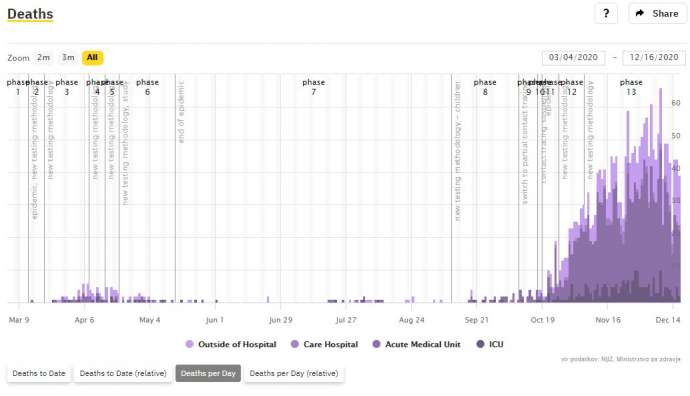STA, 16 December 2020 - Slovenia confirmed 2,107 coronavirus cases on Tuesday as nearly a third of all tests came back positive, and another 39 Covid-19 fatalities. The total number of cases since the start of the pandemic has thus passed 100,000 and the death toll has risen to 2,190.
Data released by the government show that 6,579 Sars-CoV-2 tests were performed yesterday with a positivity rate of 32%, up 4.95 percentage points compared with the day before.
Still, the number of new cases confirmed yesterday was down by 32 when compared to the figure a week ago, as the daily rise in new infections was down on the same day the week before for the fourth straight day.
The number of patients hospitalised with Covid-19 dropped by 33 to 1,251 after 128 were discharged home and 117 were newly admitted. The number of intensive care unit (ICU) cases rose by seven to 211.
The seven-day average of new cases as of Monday is 1,477, and the 14-day incidence per 100,000 residents is 1,006, government data show.
According to the tracker site covid-19.sledilnik.org, there are currently 20,785 active cases in the country, out of a total of 100,389 confirmed so far.
Addressing the daily coronavirus press briefing on Wednesday, Tatjana Lejko Zupanc, the head of the UKC Ljubljana Department of Infectious Diseases, offered a glimmer of hope.
"In recent days we have the impression the situation is calming even if just microscopically. We're not very optimistic, but there's a ray of light because we have a bed free every morning."
However, she said they were "walking the edge" and the proportion of ICU cases was increasing, while the staff was tired, on the verge of burnout, even though committed and they were looking forward to the vaccine.
She said almost half of the Covid-19 patients admitted were older than 75 and that their average age was even higher than in the first wave, at 70, compared to 65 with the average at 69. About 13% of the hospitalised Covid-patients died, which is on a par with the first wave.
Nuška Čakš Jager, deputy head of the Centre for Infectious Diseases at the National Institute of Public Health, noted that the test positivity rate had not been changing much.
Surveys conducted by epidemiologists among those infected indicate that now the primary source of infections is family or household with an increasing proportion of those who cite socialising as the source of infection.
All our stories on Slovenian and Covid-19






